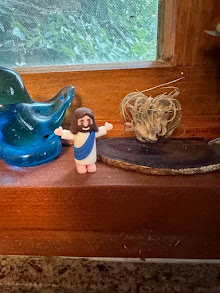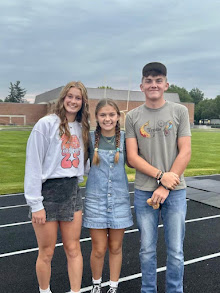 Projects were an integral part of my upbringing. Whether this situation was a natural result of German frugality or a desire to make everything better than when you started or both is not a question that need to considered. Suffice it to say my parents always saw diamonds in the rough, and when that didn't pan out, they made the absolute best of what they had to work with. The farm in Moniteau county certainly met that description. The ponds were surrounded by thickets of impenetrable honey locust; the fields were riddled with ditches; the fencing was in need of repair. The outbuildings were solid but peeling. The last owners had attempted to operate a dairy; there was a solid little concrete parlor, a tin pole shed and an immense Dutch barn surrounding a paved lot. These were all assets in my father's eyes despite their disrepair.
Projects were an integral part of my upbringing. Whether this situation was a natural result of German frugality or a desire to make everything better than when you started or both is not a question that need to considered. Suffice it to say my parents always saw diamonds in the rough, and when that didn't pan out, they made the absolute best of what they had to work with. The farm in Moniteau county certainly met that description. The ponds were surrounded by thickets of impenetrable honey locust; the fields were riddled with ditches; the fencing was in need of repair. The outbuildings were solid but peeling. The last owners had attempted to operate a dairy; there was a solid little concrete parlor, a tin pole shed and an immense Dutch barn surrounding a paved lot. These were all assets in my father's eyes despite their disrepair. The house was something else. In retrospect, my folks like to say they should have pushed it over while they had the chance. But that has never been their way. It was a shotgun house built around the original two room cabin, with high ceilings and tongue and groove cabinets built in for storage. There was a big bay window facing east in one front room. Three different front doors opened onto the south facing porch. The main features of the front yard were two antique cedars posted as sentinels on the west side of the house nearest route T. The previous owners had cobbled together a bath of sorts and put in some ugly cabinetry surrounding a new kitchen sink. The back part of the house was a labyrinth of dark little rooms that I assume had originally been the kitchen. The heating system comprised two propane stoves. It wasn't a very hospitable place, but it rested squarely on limestone blocks. The house wasn't a factor in the purchase of the farm, a not unusual situation.
I was in college then but spent time on the farm during holidays and helped haul brush, paint barns, and weed the garden my folks established with the aid of my grandfather's aged tiller. The little red and gray Ford tractor from the Calloway farm took up residence and the brush hog was put to use. I walked the fields with my father to hear of his plans for rebuilding the battered fields, fencing the ponds and designing a cattle handling facility in the lots around the barn. My parents used every bit of the aged manure in the barn to doctor the garden spot near the house; interestingly enough, it was very nice soil for mid Missouri. There was the requisite percentage of chert chunks, but not the tendency to slab. I'm spoiled now, of course; when I dig here at home, I may turn up chunks of brick, but I can hardly remember what its like to hit rock!
Over time the old house got a new lease on life. My folks built an addition with a full basement, a heat pump, a nice big kitchen and a master bedroom with bath. They tore up floors and poured concrete beneath to keep the outside from taking up residence. It has been a constant battle to keep coons, mice and other vermin from crawling in the walls, dying, and stinking up the place. The ceilings have all been paneled after one fateful winter night when the entire plaster ceiling of one front room collapsed. The lovely old furniture from my grandparent's home, much of it built by my grandfather, settled gracefully into the light filled rooms of the old farm house. Stained glass windows in the front door and the guest room door as well as a rose window in the library gave the place a touch of elegance.
 Our family visits were joyful occasions. An orchard marched in tidy rows in the field south of the house. North of the house, a well maintained hay field had replaced the milo. Up on the ride beyond the creek grew a new warm season grass pasture. We would pick walnuts in the fall, hike the creek, or down the road to the bottom, or through the woods to see the big new house the neighbor had built. We would walk behind my mom's new four wheeler to pick boxes of apples to take home or store in the market. At Christmas time we'd fill the house with family, Laura and Mark in the library, Blake and I in the big blue guest room, Lee and Ann in the little alleyway bedroom in between. Ben slept in our big room when he was a baby, but graduated to the day bed in Grandpa's ham shack when he was older. The wood stoves would crackle; the propane stoves would glow and our boisterous family would fill every room with laughter and noise.
Our family visits were joyful occasions. An orchard marched in tidy rows in the field south of the house. North of the house, a well maintained hay field had replaced the milo. Up on the ride beyond the creek grew a new warm season grass pasture. We would pick walnuts in the fall, hike the creek, or down the road to the bottom, or through the woods to see the big new house the neighbor had built. We would walk behind my mom's new four wheeler to pick boxes of apples to take home or store in the market. At Christmas time we'd fill the house with family, Laura and Mark in the library, Blake and I in the big blue guest room, Lee and Ann in the little alleyway bedroom in between. Ben slept in our big room when he was a baby, but graduated to the day bed in Grandpa's ham shack when he was older. The wood stoves would crackle; the propane stoves would glow and our boisterous family would fill every room with laughter and noise. The orchard is much reduced now: advancing years and the unforgiving humidity of Missouri both contributed. But the cattle facilities are still used, the pastures maintained and the sprouts and windfalls held at bay. The milking parlor is now an observatory and the market still serves as a shady spot for a mid morning refreshment and summering houseplants. The basement is a proxy for a life of varied interests: canning jars of fruits, QSL cards from all over the world; a virtual operating museum of old radio equipment, some hand crafted; a library of music and collection of instruments; a full ping pong table sized model train display with my mother's childhood train and the Missouri river bluffs as scenery; a wood stove to keep all dry and cozy in the wintertime.
The orchard is much reduced now: advancing years and the unforgiving humidity of Missouri both contributed. But the cattle facilities are still used, the pastures maintained and the sprouts and windfalls held at bay. The milking parlor is now an observatory and the market still serves as a shady spot for a mid morning refreshment and summering houseplants. The basement is a proxy for a life of varied interests: canning jars of fruits, QSL cards from all over the world; a virtual operating museum of old radio equipment, some hand crafted; a library of music and collection of instruments; a full ping pong table sized model train display with my mother's childhood train and the Missouri river bluffs as scenery; a wood stove to keep all dry and cozy in the wintertime.One Christmas I made a barnboard sign for my folks' farm. Laura and I pondered long and hard what phrase to paint and finally settled on 'Ruhegarten', German, we hoped, for a place of contentment and bounty. Years of working land and maintaining gardens has led me to understand better why my father turned that sign over and painted another motto: "Erhalt!" Conserve! We will never rest in peace and contentment on this side of Eden; we must be vigilant, with spade and hoe in hand, or clippers, or Roundup, or hammer, or paint, or portable drill with self tapping screws. Disorder lurks outside the gates like a ravening wolf. Maintaining the status quo is the daily grind, but making your mark on the land is a life long pilgrimage. 'Erhalt!' is a worthy motto for the folks at Redbarn, who consider stewardship of land and the works of builders past God's own work.


















You forgot Redbarn's most famous inhabitant...Mr. Apple Lion:)
ReplyDelete